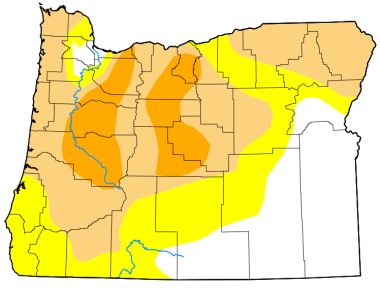
Impact of drought on fish and wildlife

Oregon drought map
Impact of drought
Prolonged drought can lead to low water levels, warm water temperatures, poor forage conditions and increased risk of wildfires. Here are just a few ways drought conditions can impact fish, birds, mammals and other wildlife.
- Low, warm water conditions are hard on native fish, especially cold water species like trout, salmon and steelhead. Under these conditions, fish are stressed and more vulnerable to low oxygen levels and disease.
- Low water levels can leave fish stranded in isolated pools with poor water conditions. In rivers and streams, low water makes migrating to and from the ocean more difficult for both juvenile and adult fish.
- Without water, forage and other food is scarcer, leaving birds and mammals weaker and their young struggling to survive.
- Decreasing water levels in the Klamath Basin and alkali lakes or wetlands of Northern Basin and Range Ecoregion can be devastating for nesting success of Oregon Conservation Strategy species such as black-necked stilt, American white pelican, Caspian tern, Franklin’s gull and sandhill crane.
- Scarce water resources impacts amphibians, as well. Amphibians rely on water throughout most of their life cycle and require a moist environment to survive. Those that do survive and reproduce face more competition in remaining pools leading to poorer growth rates, greater risks for disease transmission and lower survival of young.
- Dried up ponds an other water sources can impact reptiles like western pond turtle and western painted turtles that are partially aquatic. When water sources disappear, food is less available and predation increases.
- Prolonged drought can significantly increase the chances of catastrophic wildfires. Learn more about the impact wildfires can have on fish and wildlife.
Recreate responsibly
There are steps you can take to help fish and wildlife out during drought:
- Keep your distance from water sources that wildlife need. Camp at least 300 feet away from water sources. As small ponds and other water sources disappear, animals will start to concentrate at remaining watering holes. While this may increase the number and diversity of animals in one area – great for wildlife watching – your presence near this essential resource may place even more stress on the animals.
- Consider finding a new place to fish or swim if you are in an area with low water. Try swimming in larger water bodies where fish and other critters aren’t congregating for refuge. Anglers can try warmwater fishing or fish the cooler high lakes. The weekly recreation report is a good spot for anglers to check before going fishing. Tips for fishing in warmer water.
- Stay on trails when you hike or bike to avoid disturbing habitat. Riding an ATV through a dry stream bed can permanently damage habitat.
- Keep your dog leashed. Off-leash dogs can disrupt bird nesting habitat and put other animals on the move, draining energy reserves when animals are already stressed by drought.
- Make sure your campfires are fully out. Drought creates dangerous conditions for wildfires. Be prepared with a fire extinguisher should a fire accidentally occur from your campfire (required during fire season for vehicles and ATVs when not travelling on county or state roads).
- Scout and watch from a distance. As much as possible, try using binoculars or a spotting scope to observe wildlife and minimize disturbance during your scouting trips or when wildlife viewing.
- Find more tips for hunting, fishing and wildlife viewing responsibly during drought. And see the steps ODFW might take to help protect fish and wildlife.
Statewide drought resources
- US Drought Monitor | Oregon
- Oregon Drought Watch | current conditions
- Oregon Water Resources Department | drought resources
- Oregon-Washington BLM
- Oregon State Marine Board |Opportunity and Access Report (OAR)
- U.S. Forest Service | drought
- Oregon Department of Forestry | current wildfire information
- Governor's Drought Declaration
- National Drought Mitigation Center (NDMC | Oregon drought planning resources
- Oregon Department of Agriculture | drought and disaster resources
- Oregon’s Instream Leasing Program
- Allocation of Conserved Water Program
- Oregon’s Instream Transfer Program
Drought Outreach Toolkit
A toolkit has been created for anyone interested in helping to educate Oregonians about the impacts of drought on fish, wildlife, and habitat in Oregon. The toolkit consists of an overview of the drought outreach effort, key messages, social media tiles and sample posts, videos and other graphic elements for public use. It reviews some basic guidelines for the use of the assets and other pertinent information to anyone engaged in the outreach effort. Simply, the toolkit helps everybody sharing information to speak in one voice and stay on message about the impacts of drought on fish, wildlife, and habitat in Oregon.
Explore the drought outreach toolkit now
Other resources
- US Drought Information System: https://www.drought.gov
- NOAA Drought Page: https://www.cpc.ncep.noaa.gov/products/Drought
- National Weather Service Weather Forecast Office | PQR - Portland, OR
- National Weather Service Weather Forecast Office | MFR - Medford, OR
- National Weather Service Weather Forecast Office | PDT - Pendleton, OR
- National Weather Service Weather Forecast Office | BOI - Boise, ID



